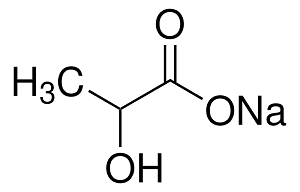Pharmaceutical & Fine Chemicals
Sodium Lactate

Product Description
Sodium lactate is a sodium salt of lactic acid, which finds various industrial applications due to its unique properties.
Product:
Sodium Lactate
CAS:
72-17-3
Synonym:
Sodium DL-lactate; Lactic acid sodium salt; Sodium 2-hydroxypropanoate
Structure:

Typical Characteristics
Appearance
White powder
Density
1.33 g/cm3
Melting point
161-162 °C
Molecular Weight
112.06
Odor
Odorless
Purity
≥99%
Refractive index
1.422-1.425
Uses, Applications & Markets
Key applications
get a quote
We Offer Sodium Lactate
in various grades
A few of the grades available are listed below:



Sodium Lactate used in many
industry applications
Sodium lactate is a sodium salt of lactic acid, which finds various industrial applications due to its unique properties. Here are some of its main uses:
- Food Industry: Sodium lactate is widely used in the food industry as a food additive and preservative. It serves as a flavor enhancer, pH regulator, and humectant in various food products, including meat, poultry, seafood, baked goods, and beverages. Additionally, it exhibits antimicrobial properties, helping to extend the shelf life of perishable foods by inhibiting the growth of bacteria and molds.
- Personal Care Products: Sodium lactate is utilized in the formulation of personal care products, such as skin care lotions, creams, and moisturizers. It acts as a moisturizing agent, enhancing the hydration and softness of the skin. Sodium lactate is also added to hair care products to improve manageability and reduce static electricity.
- Pharmaceuticals: In the pharmaceutical industry, sodium lactate is used as an excipient in the formulation of various oral and topical medications. It serves as a buffering agent, stabilizer, and osmotic agent in liquid and semi-solid dosage forms, contributing to the stability, solubility, and bioavailability of active pharmaceutical ingredients.
- Industrial Applications: Sodium lactate is employed in various industrial processes, including metalworking, electroplating, and chemical synthesis. It acts as a complexing agent, chelating metal ions to prevent oxidation and corrosion in metal surfaces. Sodium lactate is also used as a pH regulator and buffering agent in chemical reactions and industrial cleaning solutions.
- Dermatology: Sodium lactate is sometimes used in dermatology treatments for its moisturizing and keratolytic properties. It helps to hydrate dry and rough skin while promoting exfoliation and the removal of dead skin cells. Sodium lactate-containing creams or lotions are applied topically to improve the texture and appearance of the skin.
- Animal Feed: Sodium lactate is added to animal feed formulations as a source of energy and electrolytes for livestock and poultry. It helps maintain hydration and electrolyte balance in animals, particularly during periods of stress or heat exposure. Sodium lactate supplementation may also improve feed intake and nutrient absorption in livestock production.
- Biomedical Research: Sodium lactate is used in biomedical research as a cell culture medium supplement. It provides essential nutrients and buffering capacity to support cell growth and viability in laboratory settings. Sodium lactate-containing media are commonly used for cell culture experiments, tissue engineering, and bioproduction processes.
- Water Treatment: Sodium lactate is utilized in water treatment applications, particularly in the treatment of wastewater and industrial effluents. It can serve as a source of carbon for biological nutrient removal processes, promoting the growth of beneficial microorganisms that help degrade organic pollutants and remove nitrogen and phosphorus compounds from water streams.
- Textile Industry: Sodium lactate is sometimes employed in the textile industry as a dyeing assistant and finishing agent. It can improve the color fastness and uniformity of textile dyes, as well as enhance the softness and wrinkle resistance of finished fabrics. Sodium lactate may also be used in textile sizing formulations to improve fiber lubrication and reduce yarn breakage during weaving or knitting.
- Antimicrobial Applications: Sodium lactate exhibits antimicrobial properties and is sometimes used in antimicrobial formulations for disinfection and sanitation purposes. It can be incorporated into household cleaners, sanitizing wipes, and personal hygiene products to inhibit the growth of bacteria, viruses, and fungi on surfaces and skin.